Is Fig a Tropical Fruit? No!
Figs (Ficus carica) are not considered tropical fruits; they are native to the Mediterranean and Middle Eastern regions.
Figs belong to the mulberry family and have been a part of human diets for thousands of years.
They are suited to temperate climates and can endure cooler temperatures, unlike typical tropical fruits that require warm and frost-free conditions.
Figs are known for their adaptability:
Figs are versatile fruits with a rich historical and cultural significance, thriving beyond tropical environments.

Key Takeaway
4 Climate Types: Is Fig a Tropical Fruit
| Climate Type | Fruits Typical of Climate | Fig Adaptability | Notes |
|---|---|---|---|
| Tropical | Mango, Papaya, Banana | Not adapted | Figs require cooler winter temperatures. |
| Temperate | Apple, Pear, Fig | Well adapted | Figs thrive in regions with hot summers and cooler winters. |
| Mediterranean | Olive, Grape, Fig | Well adapted | The Mediterranean climate is ideal for fig cultivation. |
| Subtropical | Citrus, Avocado, Fig | Moderately adapted | Figs can grow in some subtropical areas with proper care. |
Unveiling the Fig’s Origins
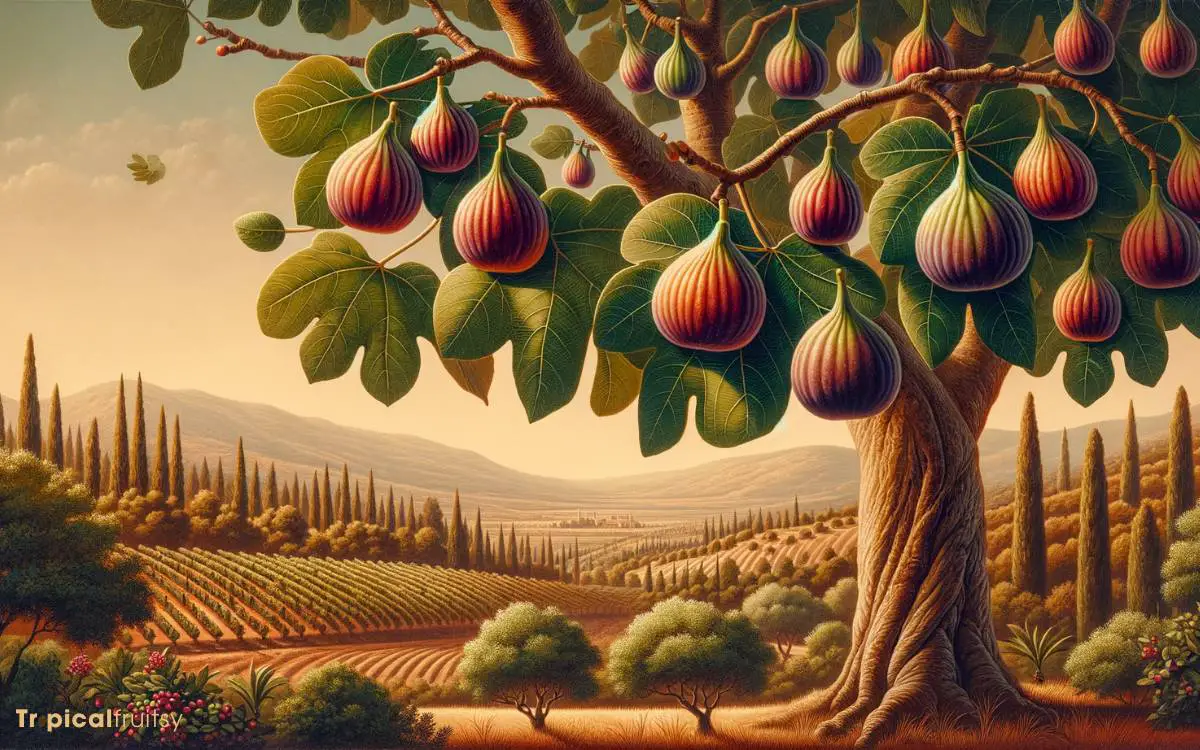
The fig, scientifically known as Ficus carica, can trace its horticultural roots back to ancient societies in the Mediterranean and Middle East regions.
This deciduous tree, a member of the Moraceae family, flourished in these areas due to their warm, arid climates, which are conducive to the species’ growth and fruit production.
Contrary to common classification as a tropical fruit, the fig is more accurately described as a temperate species.
Its broad native range, coupled with historical cultivation practices, underscores the plant’s adaptability to various ecological niches.
Analysis of the fig’s propagation, including its unique pollination process involving the fig wasp, reveals a symbiotic relationship that further delineates its departure from typical tropical fruit characteristics.
Defining Tropical Fruits
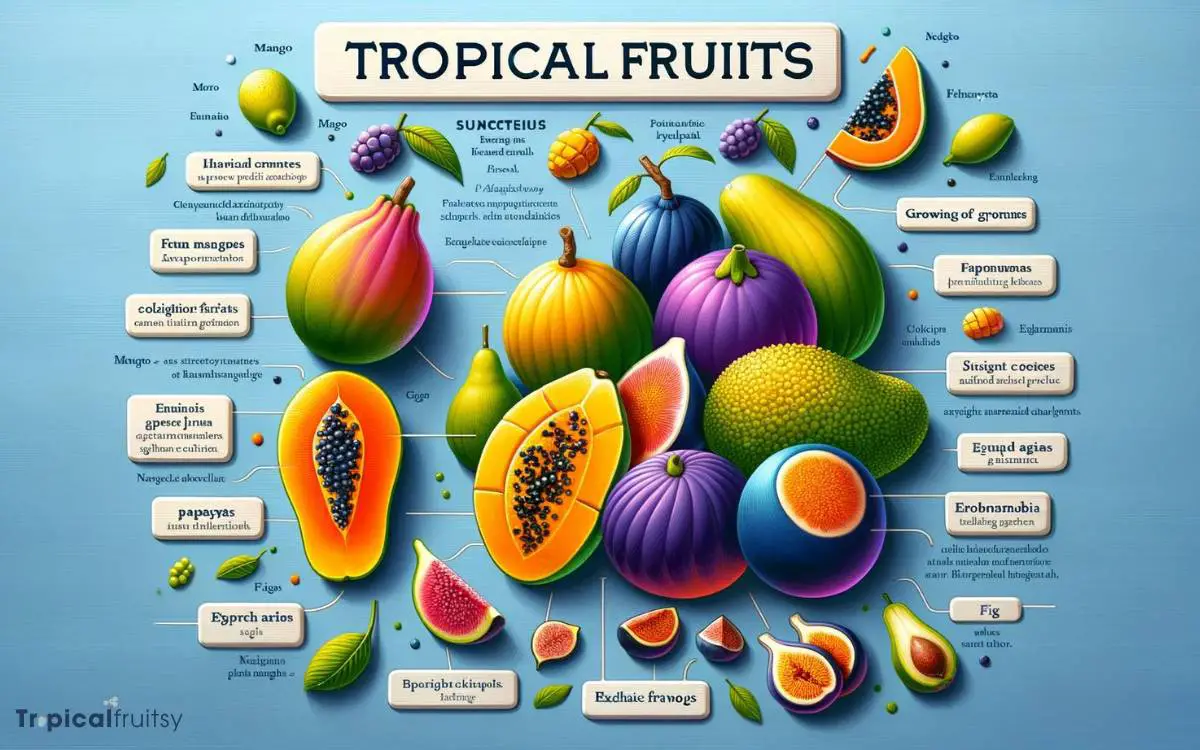
The classification of tropical fruits is grounded in specific climatic requirements and geographic origins, marking a clear distinction from temperate counterparts.
Tropical fruits typically necessitate a warm and humid environment for optimal growth, conditions that are characteristic of regions located near the equator.
An examination of these criteria provides a framework for assessing whether the fig, with its unique cultivation needs, fits within the tropical fruit category.
Climate Requirements
While tropical fruits typically thrive in warm and humid climates with little variation in temperature, the climate requirements for figs differ as they can also prosper in temperate zones.
Figs demonstrate a versatile resilience, expanding beyond the stereotypical boundaries of tropical flora.
Their adaptability can be highlighted by the following climate factors they can withstand:
- Moderate cold tolerance, surviving winter temperatures down to -10°C.
- Ability to prosper with less humidity compared to their tropical counterparts.
- Resilience in a wide range of soils, though they prefer well-drained substrates.
- Need for ample sunlight to ensure successful fruit development.
This adaptive nature serves as a testament to the fig’s complex relationship with its environment, shifting the discussion towards the geographic origins of this unique fruit.
Geographic Origins
Figs, although often associated with the Mediterranean and Middle Eastern regions, do not fall strictly within the tropical fruit category due to their broader climatic adaptability.
Native to the region that spans from Western Asia to the Mediterranean, Ficus carica, the common fig tree, thrives in temperate climates.
Tropical fruits, by definition, are those that originate and are cultivated in the tropics, a zone bounded by the Tropic of Cancer and the Tropic of Capricorn.
These fruits typically require warm, humid conditions year-round, conditions that are not necessary for the cultivation of figs.
The fig tree’s ability to flourish in varied climates, including those with cooler, temperate zones, underlines its deviation from the traditional criteria that classify a fruit as tropical.
Figs: Geographical Distribution
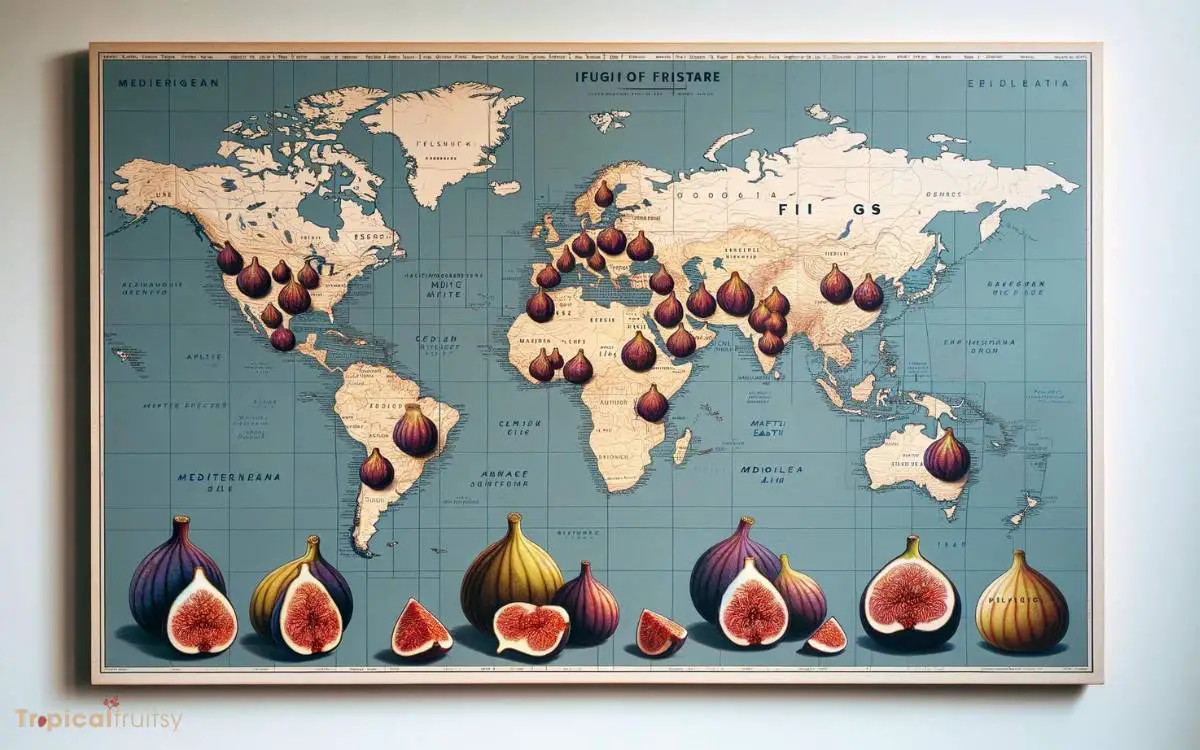
Throughout history, figs have been cultivated in a variety of climates, ranging from arid areas to Mediterranean environments, rather than being confined to strictly tropical regions.
The Ficus carica, or common fig, is native to the Middle East and western Asia but has been successfully cultivated across the globe, demonstrating a broad adaptability to numerous climate zones.
This adaptability has allowed figs to become a staple in diverse culinary traditions and agricultural practices.
- Ancient Roots: Originating in western Asia, figs carry with them the traces of ancient civilizations.
- Global Expansion: The spread across the Mediterranean signifies human ingenuity in agricultural adaptation.
- Cultural Significance: Figs symbolize abundance and fertility, resonating deeply with various societies.
- Adaptability: Their successful growth in non-tropical climates challenges the misconception of figs as purely tropical fruits.
Climatic Needs for Fig Cultivation
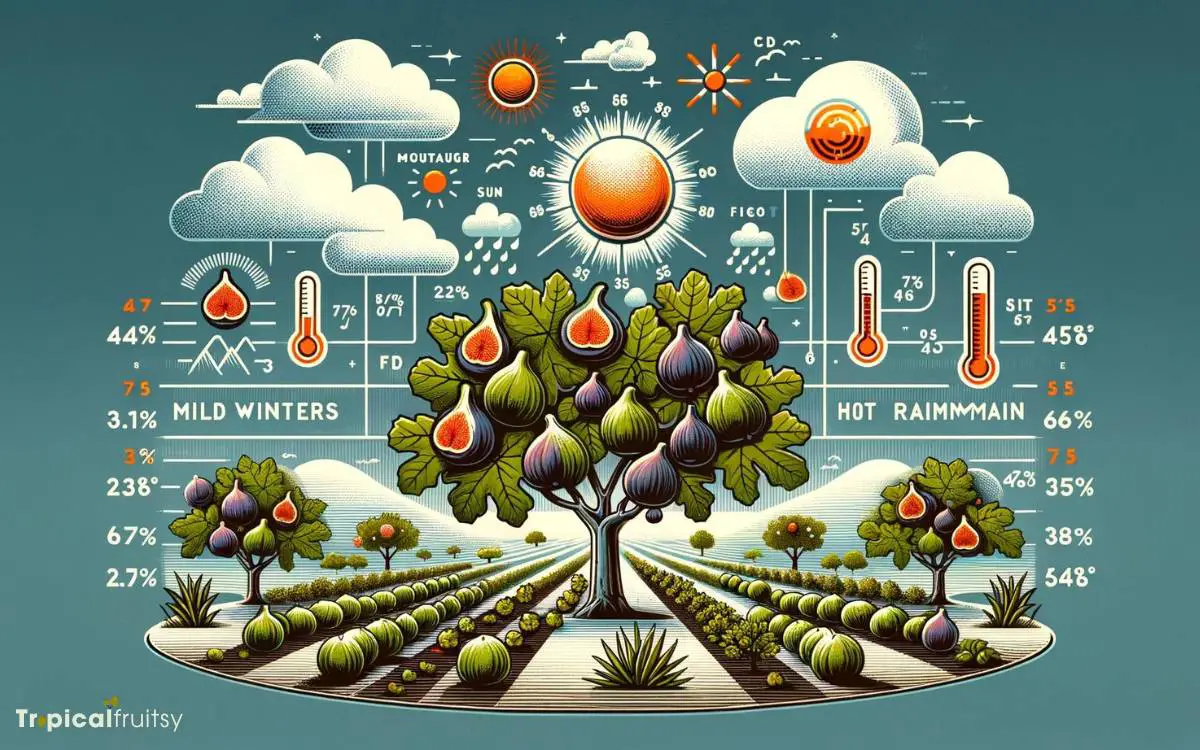
The successful cultivation of figs hinges critically on maintaining an optimal temperature range that supports the plant’s developmental cycle from germination to fruiting.
Precise irrigation practices are paramount to address the species-specific moisture needs without inducing water stress that can compromise yield and fruit quality.
An analytical approach to climatic conditions, including temperature stability and water availability, forms the cornerstone for sustainable fig production.
Optimal Temperature Range
Cultivating figs successfully requires a consistent temperature range between 15°C to 25°C (59°F to 77°F), conditions often found in Mediterranean and other similar climates.
This optimal temperature range is critical for the development of the fig’s unique fruiting cycle and for ensuring a high-quality crop yield.
To further elucidate:
- Resilience: Figs demonstrate robust growth within this thermal band, enhancing plant vigor and fruit set.
- Photosynthesis Efficiency: Optimal temperatures facilitate maximal photosynthetic activity, directly impacting fruit sweetness and nutritional value.
- Pest Management: A stable temperature mitigates pest proliferation, which can devastate crops.
- Water Utilization: Temperature influences transpiration rates and water requirements, optimizing resource use.
An analytical understanding of these factors is essential for both commercial growers and hobbyists seeking to maximize their fig production while nurturing a sustainable orchard ecosystem.
Watering Requirements
While fig trees are drought-tolerant, adequate and consistent watering is essential for optimal fruit development and tree health, particularly in regions that do not experience the frequent rainfall characteristic of tropical climates.
The irrigation regime for fig cultivation must be carefully managed to maintain a balance; overwatering can lead to root rot and other fungal diseases, while insufficient hydration can stress the tree, leading to poor yield and fruit quality.
An analytical approach to watering involves monitoring soil moisture levels and implementing drip irrigation systems to provide a steady supply of water directly to the root zone, minimizing evaporation and conserving water resources.
These technical considerations ensure the climatic needs for fig cultivation are met, paving the way to explore the diversity of fig varieties and their specific habitat preferences.
Fig Varieties and Their Habitats

Fig trees, encompassing numerous varieties, thrive in diverse climates ranging from temperate to tropical regions around the world.
The geographic distribution and adaptive qualities of these varieties have been meticulously analyzed, revealing an impressive versatility in habitat preference.
To illustrate:
- Ficus carica – Common fig; adaptable to Mediterranean climates.
- Ficus sycomorus – Sycamore fig; native to African savannas, symbolizing resilience.
- Ficus microcarpa – Chinese banyan; flourishing in subtropical conditions, embodying endurance.
- Ficus benjamina – Weeping fig; often found in Southeast Asia’s humid tropics, reflecting adaptability.
These examples, with their distinct ecological niches, underscore the fig’s remarkable plasticity.
With this understanding, we can now delve into comparing figs with tropical counterparts, assessing the nuances that distinguish them within the pantheon of fruits.
Comparing Figs With Tropical Counterparts

Commonly, figs are compared with tropical fruits to elucidate their climatic adaptability and unique botanical characteristics.
The table below contrasts figs with some of their tropical counterparts, providing a clear depiction of their differences and similarities.
| Feature | Figs | Tropical Counterparts |
|---|---|---|
| Climatic Preference | Temperate | Tropical |
| Water Requirements | Moderate | High |
| Sun Exposure | Full to Partial Sun | Full Sun |
| Soil Type | Well-Draining | Varied, often loamy |
| Edible Parts | Fruit & Leaves (varies) | Usually fruit only |
This analytical comparison reveals that while figs can thrive in warmer climates, their preferences and growth conditions differ slightly from typical tropical species.
Understanding these distinctions informs horticultural practices and enhances appreciation for the adaptability of figs.
Figs in History and Culture

Although not strictly tropical, figs have played a significant role in human history and culture, with references dating back to ancient civilizations.
The fig tree is laden with historical and cultural symbolism, often representing abundance, fertility, and peace.
Its cultivation and consumption can be traced through various epochs, serving as a testament to its enduring significance.
- Ancient Scriptures: Figs are mentioned numerous times in the Bible and the Quran, symbolizing prosperity and peace.
- Greek Traditions: In ancient Greece, figs were associated with Dionysus, the god of wine and fertility, emphasizing their cultural importance.
- Roman Practices: Romans considered figs a sacred fruit and it was illegal to cut down a fig tree.
- Cultural Festivities: Many cultures celebrate with figs during important festivals, signifying joy and unity.
This analysis indicates that figs are not merely a botanical specimen but a fruit deeply woven into the fabric of human heritage.
Are there any other fruits commonly mistaken for tropical fruits?
While many may think a grape is a tropical fruit, it is actually not. Some other fruits commonly mistaken for tropical fruits include kiwi, avocado, and passion fruit. These fruits are often associated with tropical regions due to their exotic flavors and appearances.
Deciphering the Fig’s Classification
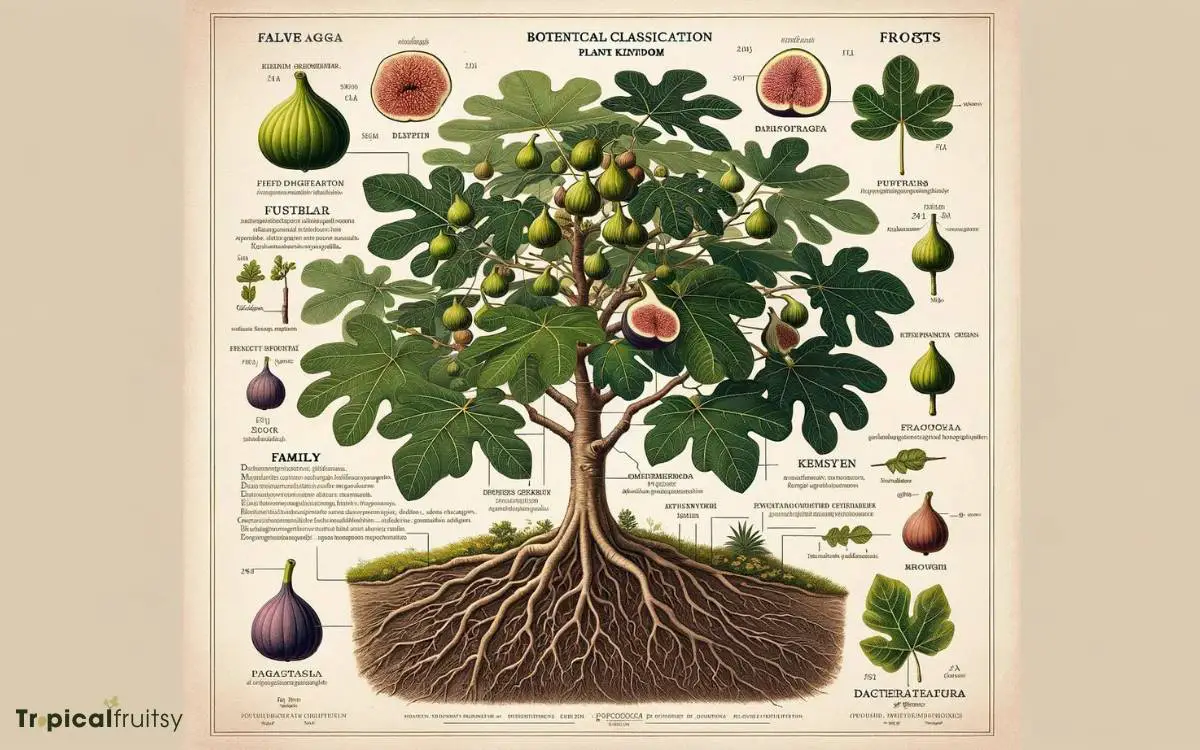
The classification of the fig, deeply embedded in cultural heritage, is scientifically known as Ficus carica, a species that thrives in both temperate and warmer climates.
This deciduous tree or shrub belongs to the Moraceae family, which includes a variety of species from woody trees to shrubs and vines.
Ficus carica is indigenous to the Middle East and western Asia but has been cultivated since ancient times for its sweet fruit, which delights the palate and provides nutritional benefits.
Taxonomically, Ficus carica is categorized under the Plantae kingdom, Magnoliophyta division, Magnoliopsida class, Rosales order, and Moraceae family.
The complexity of its pollination ecology, involving a symbiotic relationship with the fig wasp, reflects the evolutionary intricacies that have shaped its successful cultivation across varied climatic regions, extending beyond what is typically considered tropical.
Conclusion
The fig, with origins in the Fertile Crescent and a dispersion across Mediterranean and subtropical zones, defies simple classification within tropical fruit categories.
Its cultivation, reliant on specific climatic conditions, and the diversity of its varieties, demonstrate a broader ecological adaptability.
Historical significance and cultural integration further underscore its distinct identity, distinguishing the fig from its tropical counterparts and affirming its place in a unique botanical and agricultural niche.






